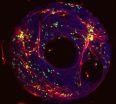(Press-News.org) PITTSBURGH—University of Pittsburgh researchers have reproduced the brain's complex electrical impulses onto models made of living brain cells that provide an unprecedented view of the neuron activity behind memory formation.
The team fashioned ring-shaped networks of brain cells that were not only capable of transmitting an electrical impulse, but also remained in a state of persistent activity associated with memory formation, said lead researcher Henry Zeringue [zuh-rang], a bioengineering professor in Pitt's Swanson School of Engineering. Magnetic resonance images have suggested that working memories are formed when the cortex, or outer layer of the brain, launches into extended electrical activity after the initial stimulus, Zeringue explained. But the brain's complex structure and the diminutive scale of neural networks mean that observing this activity in real time can be nearly impossible, he added.
The Pitt team, however, was able to generate and prolong this excited state in groups of 40 to 60 brain cells harvested from the hippocampus of rats—the part of the brain associated with memory formation. In addition, the researchers produced the networks on glass slides that allowed them to observe the cells' interplay. The work was conducted in Zeringue's lab by Pitt bioengineering doctoral student Ashwin Vishwanathan, who most recently reported the work in the Royal Society of Chemistry (UK) journal, Lab on a Chip. Vishwanathan coauthored the paper with Zeringue and Guo-Qiang Bi, a neurobiology professor in Pitt's School of Medicine. The work was conducted through the Center for the Neural Basis of Cognition, which is jointly operated by Pitt and Carnegie Mellon University.
To produce the models, the Pitt team stamped adhesive proteins onto silicon discs. Once the proteins were cultured and dried, cultured hippocampus cells from embryonic rats were fused to the proteins and then given time to grow and connect to form a natural network. The researchers disabled the cells' inhibitory response and then excited the neurons with an electrical pulse.
Zeringue and his colleagues were able to sustain the resulting burst of network activity for up to what in neuronal time is 12 long seconds. Compared to the natural duration of .25 seconds at most, the model's 12 seconds permitted an extensive observation of how the neurons transmitted and held the electrical charge, Zeringue said.
Unraveling the mechanics of this network communication is key to understanding the cellular and molecular basis of memory creation, Zeringue said. The format developed at Pitt makes neural networks more accessible for experimentation. For instance, the team found that when activity in one neuron is suppressed, the others respond with greater excitement.
"We can look at neurons as individuals, but that doesn't reveal a lot," Zeringue said. "Neurons are more connected and interdependent than any other cell in the body. Just because we know how one neuron reacts to something, a whole network can react not only differently, but sometimes in the complete opposite manner predicted."
Zeringue will next work to understand the underlying factors that govern network communication and stimulation, such as the various electrical pathways between cells and the genetic makeup of individual cells.
INFORMATION:
Pitt team recreates brain cell networks with new view of activity behind memory formation
A team based in Pitt's Swanson School of Engineering produced and observed the extended electrical charge associated with working memory using living-cell models of neural networks that reveal the complex, diminutive world of brain cells
2011-05-26
ELSE PRESS RELEASES FROM THIS DATE:
Violent video games reduce brain response to violence and increase aggressive behavior
2011-05-26
VIDEO:
Scientists have known for years that playing violent video games causes players to become more aggressive. The findings of a new University of Missouri study provide one explanation for...
Click here for more information.
COLUMBIA, Mo. – Scientists have known for years that playing violent video games causes players to become more aggressive. The findings of a new University of Missouri (MU) study provide one explanation for why this occurs: the brains of violent ...
Many patients fail to properly take oral chemo, leading to complications
2011-05-26
EAST LANSING, Mich. — As the use of oral chemotherapy continues to rise, researchers from Michigan State University have discovered many patients fail to properly take the cancer-fighting medication, a significant clinical problem that can result in complications and premature death.
That lack of adherence needs to be addressed by the health care community, said College of Nursing researcher Barbara Given, who led the study that is published in the May edition of Seminars in Oncology Nursing.
"Given the increasing use of oral chemotherapy in treating cancer, patient ...
Big bucks for MLB megastars mean big team profits, but fewer wins
2011-05-26
ANN ARBOR, Mich.---Spending top dollar for megastar players like Miguel Cabrera and Alex Rodriguez helps Major League Baseball teams attract fans and earn higher profits, but clubs that spend the bulk of their player payroll on a couple of superstars ultimately win fewer games, a University of Michigan study shows.
"Superstars who are paid more could bring more to the team in terms of profits," said Jason Winfree, an associate professor of sport management at the U-M School of Kinesiology. "The flip side of that is that a more equitable pay scale among all players results ...
Protein drinks after exercise help maintain aging muscles
2011-05-26
Bethesda, MD—A new research report appearing online in the FASEB Journal (http://www.fasebj.org) shows that what someone drinks after exercise plays a critical role in maximizing the effects of exercise. Specifically, the report shows that protein drinks after aerobic activity increases the training effect after six weeks, when compared to carbohydrate drinks. Additionally, this study suggests that this effect can be seen using as little as 20 grams of protein.
"It is not a mystery that exercise and nutrition help slow the aging process," said Benjamin F. Miller, Ph.D., ...
Unique nerve-stimulation treatment proves effective against drug-resistant epilepsy
2011-05-26
Medications are the mainstay of treatment for epilepsy, but for a considerable number of patients — estimated to be as many as 1 million in the U.S. — drugs don't work. These patients suffer from a type of epilepsy known as refractory or drug-resistant epilepsy, in which drugs can't control their seizures.
But at an epilepsy conference last month, Dr. Christopher DeGiorgio, a UCLA professor of neurology, presented the results of a non-invasive, non-pharmaceutical treatment that shows promise in controlling seizures.
In his talk at the Antiepileptic Drug Trials XI ...
Losing more than 15 percent of body weight significantly boosts vitamin D levels in overweight women
2011-05-26
SEATTLE – Overweight or obese women with less-than-optimal levels of vitamin D who lose more than 15 percent of their body weight experience significant increases in circulating levels of this fat-soluble nutrient, according to a new study by researchers at Fred Hutchinson Cancer Research Center.
"Since vitamin D is generally lower in persons with obesity, it is possible that low vitamin D could account, in part, for the link between obesity and diseases such as cancer, heart disease and diabetes," said Caitlin Mason, Ph.D., lead author of the paper, published online May ...
High-fat diet during pregnancy programs child for future diabetes
2011-05-26
URBANA – A high-fat diet during pregnancy may program a woman's baby for future diabetes, even if she herself is not obese or diabetic, says a new University of Illinois study published in the Journal of Physiology.
"We found that exposure to a high-fat diet before birth modifies gene expression in the livers of offspring so they are more likely to overproduce glucose, which can cause early insulin resistance and diabetes," said Yuan-Xiang Pan, a U of I professor of nutrition.
The high-fat diet that caused these changes was a typical Western diet that contained 45 percent ...
'I can hear a building over there'
2011-05-26
It is common knowledge that bats and dolphins echolocate, emitting bursts of sounds and then listening to the echoes that bounce back to detect objects. What is less well-known is that people can echolocate too. In fact, there are blind people who have learned to make clicks with their mouths and to use the returning echoes from those clicks to sense their surroundings. Some of these individuals are so adept at echolocation that they can use this skill to navigate unknown environments, and participate in activities such as mountain biking and basketball.
Researchers at ...
Mars: Red planet's rapid formation explains its small size relative to Earth
2011-05-26
Mars developed in as little as two to four million years after the birth of the solar system, far more quickly than Earth, according to results of a new study published in this week's issue of the journal Nature.
The red planet's rapid formation helps explain why it is so small, say the study's co-authors, Nicolas Dauphas at the University of Chicago and Ali Pourmand at the University of Miami.
Their research was funded by the National Science Foundation (NSF).
Mars probably is not a terrestrial planet like Earth, which grew to its full size over 50 to 100 million ...
Scientists discover the largest assembly of whale sharks ever recorded
2011-05-26
Whale sharks (Rhincodon typus) are often thought to be solitary behemoths that live and feed in the open ocean. Scientists at the Smithsonian Institution and colleagues, however, have found that this is not necessarily the case, finding that whale sharks can be gregarious and amass in the hundreds to feed in coastal waters.
Aggregations, or schools, of whale sharks have been witnessed in the past, ranging from several individual sharks to a few dozen. However this new research, which involved both surface and aerial surveys, has revealed an enormous aggregation of whale ...
LAST 30 PRESS RELEASES:
Learning about public consensus on climate change does little to boost people’s support for action, study shows
Sylvester Cancer Tip Sheet for January 2026
The Global Ocean Ship-Based Hydrographic Investigations Program (GO-SHIP) receives the Ocean Observing Team Award
Elva Escobar Briones selected for The Oceanography Society Mentoring Award
Why a life-threatening sedative is being prescribed more often for seniors
Findings suggest that certain medications for Type 2 diabetes reduce risk of dementia
UC Riverside scientists win 2025 Buchalter Cosmology Prize
SETI Institute opens call for nominations for the 2026 Tarter Award
Novel theranostic model shows curative potential for gastric and pancreatic tumors
How beige fat keeps blood pressure in check
Fossils reveal ‘latitudinal traps’ that increased extinction risk for marine species
Review: The opportunities and risks of AI in mental health research and care
New map reveals features of Antarctic’s ice-covered landscape
Beige fat promotes healthy vascular function and blood pressure in mice
Chronic low-dose pesticide exposure reduces the life span of wild lake fish, China-based study shows
Tiny earthquakes reveal hidden faults under Northern California
Long-term pesticide exposure accelerates aging and shortens lifespan in fish
Professor Tae-Woo Lee's research group develops groundbreaking perovskite display technology demonstrating the highest efficiency and industry-level operational lifetime
The “broker” family helps tidy up the cell
Ecology: Mummified cheetahs discovery gives hope for species’ Arabic reintroduction
Researchers survey the ADHD coaching boom
Air pollution and cardiac remodeling and function in patients with breast cancer
Risk of suicide in patients with traumatic injuries
Post–intensive care syndrome
The lifesaving potential of opioid abatement funds
The Frontiers of Knowledge Award goes to Allan MacDonald and Pablo Jarillo-Herrero for their discovery of the “magic angle” enabling science to transform and control the behavior of new materials
Discovery reveals how keto diet can prevent seizures when drugs fail
JMIR Publications and Sikt announce pilot flat-fee unlimited open access partnership
Finding new cell markers to track the most aggressive breast cancer in blood
A new, cleaner way to make this common fertilizer
[Press-News.org] Pitt team recreates brain cell networks with new view of activity behind memory formationA team based in Pitt's Swanson School of Engineering produced and observed the extended electrical charge associated with working memory using living-cell models of neural networks that reveal the complex, diminutive world of brain cells



